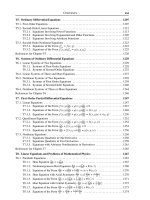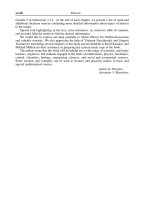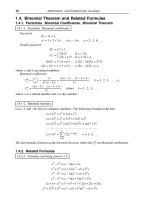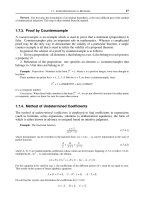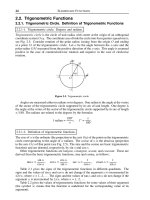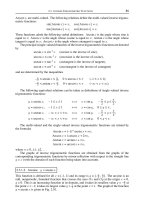Handbook of mathematics for engineers and scienteists part 82 docx
Bạn đang xem bản rút gọn của tài liệu. Xem và tải ngay bản đầy đủ của tài liệu tại đây (409.77 KB, 7 trang )
12.6. LINEAR SYSTEMS OF ORDINARY DIFFERENTIAL EQUATIONS 535
By convention, for clearness and convenience of interpretation of the results, t will be used
to designate the independent variable and will be treated as time. A solution x = x(t),
y = y(t) of system (12.6.1.25) plotted in the plane x, y (the phase plane) is called a (phase)
trajectory of the system.
A solution to system (12.6.1.25) will be sought in the form
x = k
1
e
λt
, y = k
2
e
λt
.(12.6.1.26)
On substituting (12.6.1.26) into (12.6.1.25), one obtains the characteristic equation for the
exponent λ:
a
11
– λa
12
a
21
a
22
– λ
= 0,orλ
2
–(a
11
+ a
22
)λ + a
11
a
22
– a
12
a
21
= 0.(12.6.1.27)
The coefficients k
1
and k
2
are found as
k
1
= Ca
12
, k
2
= C(λ – a
11
), (12.6.1.28)
where C is an arbitrary constant. To two different roots of the quadratic equation (12.6.1.27)
there correspond two pairs of coefficients (12.6.1.28).
Denote the discriminant of the quadratic equation (12.6.1.27) by
D =(a
11
– a
22
)
2
+ 4a
12
a
21
.(12.6.1.29)
Three situations are possible.
1
◦
.IfD > 0, the roots of the characteristic equation (12.6.1.27) are real and distinct
(λ
1
≠ λ
2
):
λ
1,2
=
1
2
(a
11
+ a
22
)
1
2
√
D.
The general solution of system (12.6.1.25) is expressed as
x = C
1
a
12
e
λ
1
t
+ C
2
a
12
e
λ
2
t
,
y = C
1
(λ
1
– a
11
)e
λ
1
t
+ C
2
(λ
2
– a
11
)e
λ
2
t
,
(12.6.1.30)
where C
1
and C
2
are arbitrary constants. For C
1
= 0, C
2
≠ 0 and C
2
= 0, C
1
≠ 0,the
trajectories in the phase plane x, y are straight lines. Four cases are possible here.
1.1. Two negative real roots, λ
1
< 0 and λ
2
< 0. This corresponds to a
11
+ a
22
< 0 and
a
11
a
22
–a
12
a
21
>0. The equilibrium point is asymptotically stable and all trajectories starting
within a small neighborhood of the origin tend to the origin as t →∞.ToC
1
= 0, C
2
≠ 0
and C
2
= 0, C
1
≠ 0 there correspond straight lines passing through the origin. Figure 12.4 a
depicts the arrangement of the phase trajectories near an equilibrium point called a stable
node (or a sink). The direction of motion along the trajectories with increasing t is shown
by arrows.
O
()a
stable node
(sink)
λ <0, λ <0
12
()b
O
unstable node
(source)
λ >0, λ >0
12
Figure 12.4. Phase trajectories of a system of differential equations near an equilibrium point of the node type.
536 ORDINARY DIFFERENTIAL EQUATIONS
1.2. λ
1
> 0 and λ
2
> 0. This corresponds to a
11
+ a
22
> 0 and a
11
a
22
– a
12
a
21
> 0.
The phase trajectories in the vicinity of the equilibrium point have the same pattern as in
the preceding case; however, the trajectories go in the opposite direction, away from the
equilibrium point; see Fig. 12.4 b. An equilibrium point of this type is called an unstable
node (or a source).
1.3. λ
1
> 0 and λ
2
< 0 (or λ
1
< 0 and λ
2
> 0). This corresponds to a
11
a
22
– a
12
a
21
< 0.
In this case, the equilibrium point is also unstable, since the trajectory (12.6.1.30) with
C
2
= 0 goes beyond a small neighborhood of the origin as t increases. If C
1
C
2
≠ 0, then the
trajectories leave the neighborhood of the origin as t → –∞ and t →∞. An equilibrium
point of this type is called a saddle (or a hyperbolic point); see Fig. 12.5.
O
λ >0,λ <0
(λ <0, > )λ 0
saddle
1
1
2
2
Figure 12.5. Phase trajectories of a system of differential equations near an equilibrium point of the saddle
type.
1.4. λ
1
= 0 and λ
2
= a
11
+a
22
≠ 0. This corresponds to a
11
a
22
–a
12
a
21
= 0. The general
solution of system (12.6.1.25) is expressed as
x = C
1
a
12
+ C
2
a
12
e
(a
11
+a
22
)t
,
y =–C
1
a
11
+ C
2
a
22
e
(a
11
+a
22
)t
,
(12.6.1.31)
where C
1
and C
2
are arbitrary constants. By eliminating time t from (12.6.1.31), one
obtains a family of parallel lines defined by the equation a
22
x – a
12
y = a
12
(a
11
+ a
22
)C
1
.
To C
2
= 0 in (12.6.1.31) there corresponds a one-parameter family of equilibrium points
that lie on the straight line a
11
x + a
12
y = 0.
(i) If λ
2
< 0, then the trajectories approach the equilibrium point lying as t →∞;see
Fig. 12.6. The equilibrium point x = y = 0 is stable (or neutrally stable)—there is no
asymptotic stability.
O
x
y
λ=0, λ <0
ax ay+=0
1
11 12
2
Figure 12.6. Phase trajectories of a system of differential equations near a set of equilibrium points located on
a straight line.
12.6. LINEAR SYSTEMS OF ORDINARY DIFFERENTIAL EQUATIONS 537
(ii) If λ
2
> 0, the trajectories have the same pattern as in case (i), but they go, as t →∞,
in the opposite direction, away from the equilibrium point. The point x = y = 0 is unstable.
2
◦
.IfD < 0, the characteristic equation (12.6.1.27) has complex-conjugate roots:
λ
1,2
= α iβ, α =
1
2
(a
11
+ a
22
), β =
1
2
|D|, i
2
=–1.
The general solution of system (12.6.1.25) has the form
x = e
αt
[C
1
cos(βt)+C
2
sin(βt)],
y = e
αt
[C
∗
1
cos(βt)+C
∗
2
sin(βt)],
(12.6.1.32)
where C
1
and C
2
are arbitrary constants, and C
∗
1
and C
∗
2
are defined by linear combinations
of C
1
and C
2
. The following cases are possible.
2.1. For α < 0, the trajectories in the phase plane are spirals asymptotically approaching
the origin of coordinates (the equilibrium point) as t →∞; see Fig. 12.7 a. Therefore the
equilibrium point is asymptotically stable and is called a stable focus (also a stable spiral
point or a spiral sink). A focus is characterized by the fact that the tangent to a trajectory
changes its direction all the way to the equilibrium point.
O O
()a
α <0 α >0
stable focus
(spiral sink)
()b
unstable focus
(spiral source)
stable focus
(spiral sink)
Figure 12.7. Phase trajectories of a system of differential equations near an equilibrium point of the focus type.
2.2. For α > 0, the phase trajectories are also spirals, but unlike the previous case they
spiral away from the origin as t →∞; see Fig. 12.7 b. Therefore such an equilibrium point
is called an unstable focus (also an unstable spiral point or a spiral source).
2.3. At α = 0, the phase trajectories are closed curves, containing the equilibrium point
inside (see Fig. 12.8). Such an equilibrium point is called a center. A center is a stable
equilibrium point. Note that there is no asymptotic stability in this case.
O
α=0
center
Figure 12.8. Phase trajectories of a system of differential equations near an equilibrium point of the center
type.
538 ORDINARY DIFFERENTIAL EQUATIONS
3
◦
.IfD = 0, the characteristic equation (12.6.1.27) has a double real root, λ
1
= λ
2
=
1
2
(a
11
+ a
22
). The following cases are possible.
3.1. If λ
1
= λ
2
= λ < 0, the general solution of system (12.6.1.25) has the form
x = a
12
(C
1
+ C
2
t)e
λt
,
y =[(λ – a
11
)C
1
+ C
2
+ C
2
(λ – a
11
)t]e
λt
,
(12.6.1.33)
where C
1
and C
2
are arbitrary constants.
Since there is a rapidly decaying factor, e
λt
, all trajectories tend to the equilibrium point
as t →∞; see Fig. 12.9 a.ToC
2
= 0 there corresponds a straight line in the phase plane x, y.
The equilibrium point is asymptotically stable and is called a stable node (a sink). Such a
node is in intermediate position between a node from Item 1.1 and a focus from Item 2.1.
unstable node
(source)
OO
()a ()b
λ=λ<0
stable node
(sink)
12
λ=λ>0
12
Figure 12.9. Phase trajectories of a system of differential equations near an equilibrium point of the node type
in the case of a double root, λ
1
= λ
2
.
3.2. If λ
1
= λ
2
= λ > 0, the general solution of system (12.6.1.25) is determined by
formulas (12.6.1.33). The phase trajectories are similar to those from Item 3.1, but they
go in the opposite direction, as t →∞, rapidly away from the equilibrium point. Such an
equilibrium point is called an unstable node (a source); see Fig. 12.9 b.
3.3. If λ
1
= λ
2
= 0, which corresponds to
a
11
+ a
22
= 0 and a
11
a
22
– a
12
a
21
= 0
simultaneously, the general solution of system (12.6.1.25) is obtained by substituting λ = 0
into (12.6.1.33) and has the form
x = a
12
C
1
+ a
12
C
2
t,
y = C
2
– a
11
C
1
– a
11
C
2
t.
For a
12
≠ 0 all trajectories are parallel straight lines. As t → ∞, the trajectories go away
from the origin. The equilibrium point is unstable.
For clearness, the classification results for equilibrium points of systems of two linear
constant-coefficient differential equations (12.6.1.25) are summarized in Table 12.5.
Remark. For general definitions of a stable and an unstable equilibrium point, see Section 7.3.
12.6. LINEAR SYSTEMS OF ORDINARY DIFFERENTIAL EQUATIONS 539
TABLE 12.5
Classification of equilibrium points for systems of constant-coefficient equations (12.6.1.25);
the symbols ◦ and ∗ indicate stable and unstable equilibrium points, respectively, where not clearly stated
Discriminant D,
formula (12.6.1.29)
Roots of quadratic
equation (12.6.1.27), λ
1
and λ
2
Conditions for coefficients of
differential equations (12.6.1.25)
Type of equilibrium points or
shape of phase trajectories
D > 0
λ
1
< 0, λ
2
< 0, λ
1
≠ λ
2
λ
1
> 0, λ
2
> 0, λ
1
≠ λ
2
roots have unlike signs
λ
1
= 0, λ
2
< 0
λ
1
= 0, λ
2
> 0
a
11
+a
22
< 0, a
11
a
22
–a
12
a
21
> 0
a
11
+a
22
> 0, a
11
a
22
–a
12
a
21
> 0
a
11
a
22
–a
12
a
21
< 0
a
11
+a
22
< 0, a
11
a
22
–a
12
a
21
= 0
a
11
+a
22
> 0, a
11
a
22
–a
12
a
21
= 0
stable node
unstable node
saddle
∗
parallel lines
◦
parallel lines
∗
D < 0
λ
1,2
= α iβ, α > 0
λ
1,2
= α iβ, α < 0
λ
1,2
= iβ, imaginary roots
a
11
+a
22
< 0,(a
11
–a
22
)
2
+4a
12
a
21
< 0
a
11
+a
22
> 0,(a
11
–a
22
)
2
+4a
12
a
21
< 0
a
11
+a
22
= 0, a
11
a
22
–a
12
a
21
> 0
stable focus
unstable focus
center
◦
D = 0
λ
1
= λ
2
< 0
λ
1
= λ
2
> 0
λ
1
= λ
2
= 0
a
11
+a
22
< 0,(a
11
–a
22
)
2
+4a
12
a
21
= 0
a
11
+a
22
> 0,(a
11
–a
22
)
2
+4a
12
a
21
= 0
a
11
+a
22
= 0, a
11
a
22
–a
12
a
21
= 0
stable node
unstable node
saddle
∗
parallel lines
∗
12.6.2. Systems of Linear Variable-Coefficient Equations
12.6.2-1. Homogeneous systems of linear first-order equations.
1
◦
. In general, a homogeneous linear system of variable-coefficient first-order ordinary
differential equations has the form
y
1
= f
11
(x)y
1
+ f
12
(x)y
2
+ ···+ f
1n
(x)y
n
,
y
2
= f
21
(x)y
1
+ f
22
(x)y
2
+ ···+ f
2n
(x)y
n
,
y
n
= f
n1
(x)y
1
+ f
n2
(x)y
2
+ ···+ f
nn
(x)y
n
,
(12.6.2.1)
where the prime denotes a derivative with respect to x. It is assumed further on that the
functions f
ij
(x) are continuous of an interval a ≤ x ≤ b (intervals are allowed with a =–∞
or/and b =+∞).
Any homogeneous linear system of the form (12.6.2.1) has the trivial particular solution
y
1
= y
2
= ··· = y
n
= 0.
Superposition principle for a homogeneous system: any linear combination of particular
solutions to system (12.6.2.1) is also a solution to this system.
2
◦
.Let
y
k
=(y
k1
, y
k2
, , y
kn
)
T
, y
km
= y
km
(x); k, m = 1, 2, , n (12.6.2.2)
be nontrivial particular solutions of the homogeneous system of equations (12.6.2.1). So-
lutions (12.6.2.2) are linearly independent if the Wronskian determinant is nonzero:
W (x) ≡
y
11
(x) y
12
(x) ··· y
1n
(x)
y
21
(x) y
22
(x) ··· y
2n
(x)
.
.
.
.
.
.
.
.
.
.
.
.
y
n1
(x) y
n2
(x) ··· y
nn
(x)
≠ 0.(12.6.2.3)
If condition (12.6.2.3) is satisfied, the general solution of the homogeneous system
(12.6.2.1) is expressed as
y = C
1
y
1
+ C
2
y
2
+ ···+ C
n
y
n
,(12.6.2.4)
where C
1
, C
2
, , C
n
are arbitrary constants. The vector functions y
1
, y
2
, , y
n
in
(12.6.2.4) are called fundamental solutions of system (12.6.2.1).
540 ORDINARY DIFFERENTIAL EQUATIONS
3
◦
. Suppose condition (12.6.2.3) is met. Then the Liouville formula
W (x)=W (x
0
)exp
x
x
0
n
s=1
f
ss
(t)
dt
holds.
C
OROLLARY.
Particular solutions (12.6.2.2) are linearly independent on the interval
[a, b]
if and only if there exists a point
x
0
[a, b]
such that the Wronskian determinant is
nonzero at
x
0
:
W (x
0
) ≠ 0
.
4
◦
. Suppose a nontrivial particular solution of system (12.6.2.1),
y
1
=(u
1
, u
2
, , u
n
)
T
, u
m
= u
m
(x), m = 1, 2, , n,
is known. Then the number of unknowns can be reduced by one. To this end, one considers
the auxiliary homogeneous linear system of n – 1 equations
z
k
=
n
q=2
f
kq
(x)–
u
k
(x)
u
1
(x)
f
1q
(x)
z
q
, k = 2, , n.(12.6.2.5)
Let
z
p
=(z
p2
, z
p3
, , z
pn
)
T
, z
mk
= z
mk
(x); p = 2, , n,
be a fundamental system of solutions to system (12.6.2.5) and let
Z
p
=(0, z
p2
, z
p3
, , z
pn
)
T
, F
p
(x)=
1
u
1
(x)
n
s=2
f
1s
(x)z
ps
(x)
dx, p = 2, , n,
the vector Z
p
having an additional component compared with z
p
. Then the vector functions
y
p
= F
p
(x)y
1
+ z
p
(p = 2, , n) together with y
1
form a fundamental system of solutions
to the initial homogeneous system of equations (12.6.2.1).
12.6.2-2. Nonhomogeneous systems of linear first-order equations.
1
◦
. In general, a nonhomogeneous linear system of variable-coefficient first-order differ-
ential equations has the form
y
1
= f
11
(x)y
1
+ f
12
(x)y
2
+ ···+ f
1n
(x)y
n
+ g
1
(x),
y
2
= f
21
(x)y
1
+ f
22
(x)y
2
+ ···+ f
2n
(x)y
n
+ g
2
(x),
y
n
= f
n1
(x)y
1
+ f
n2
(x)y
2
+ ···+ f
nn
(x)y
n
+ g
n
(x).
(12.6.2.6)
Alternatively, the system can be written in the short vector-matrix notation as
y
= f(x)y + g(x),
with f(x)=
f
ij
(x)
being the matrix of equation coefficients and g(x)=
g
1
(x), g
2
(x),
, g
n
(x)
T
being the vector function defining the nonhomogeneous part of the equations.
12.6. LINEAR SYSTEMS OF ORDINARY DIFFERENTIAL EQUATIONS 541
E
XISTENCE AND UNIQUENESS THEOREM.
Let the functions
f
ij
(x)
and
g
i
(x)
be continu-
ous on an interval
a < x < b
. Then, for any set of values
x
◦
,
y
◦
1
,
,
y
◦
n
,where
a < x
◦
< b
,
there exists a unique solution
y
1
= y
1
(x)
,
,
y
n
= y
n
(x)
satisfying the initial conditions
y
1
(x
◦
)=y
◦
1
, , y
n
(x
◦
)=y
◦
n
,
and this solution is defined on the whole interval
a < x < b
.
2
◦
.Let
¯
y =(¯y
1
, ¯y
2
, , ¯y
n
)
T
, ¯y
k
= ¯y
k
(x); k = 1, 2, , n,
be a particular solution to the nonhomogeneous system of equations (12.6.2.6). The general
solution of this system is the sum of the general solution of the corresponding homogeneous
system (12.6.2.1), which corresponds to g
k
(x) ≡ 0 in (12.6.2.6), and any particular solution
of the nonhomogeneous system (12.6.2.6), or
y = C
1
y
1
+ C
2
y
2
+ ···+ C
n
y
n
+
¯
y,(12.6.2.7)
where y
1
, y
2
, , y
n
are linearly independent solutions of the homogeneous system
(12.6.2.1).
3
◦
. Given a fundamental system of solutions y
km
(x) (12.6.2.2) of the homogeneous system
(12.6.2.1), a particular solution of the nonhomogeneous system (12.6.2.6) is found as
¯y
k
=
n
m=1
y
mk
(x)
W
m
(x)
W (x)
dx, k = 1, 2, , n,
where W
m
(x) is the determinant obtained by replacing the mth row in the Wronskian
determinant (12.6.2.3) by the row of free terms, g
1
(x), g
2
(x), , g
n
(x), of equation
(12.6.2.6). The general solution of the nonhomogeneous system (12.6.2.6) is given by
(12.6.2.7).
4
◦
. Superposition principle for a nonhomogeneous system. A particular solution, y =
¯
y,of
the nonhomogeneous system of linear differential equations,
y
= f(x)y +
m
k=1
g
k
(x),
isgivenbythesum
y =
m
k=1
y
k
,
where the y
k
are particular solutions of m (simpler) systems of equations
y
k
= f(x)y
k
+ g
k
(x), k = 1, 2, , m,
corresponding to individual nonhomogeneous terms of the original system.



